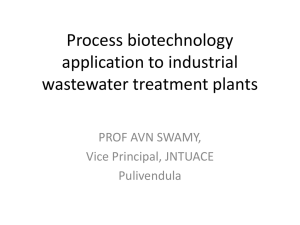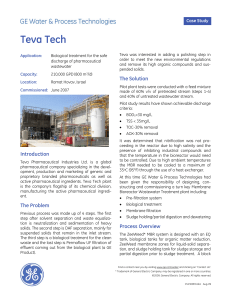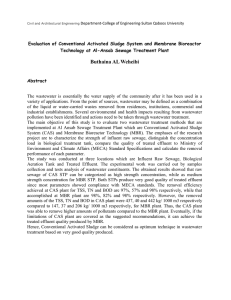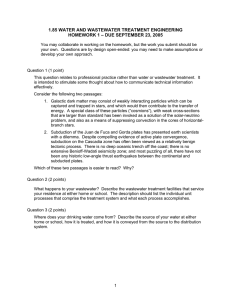WASDA as a Decision Support System for Membrane
advertisement
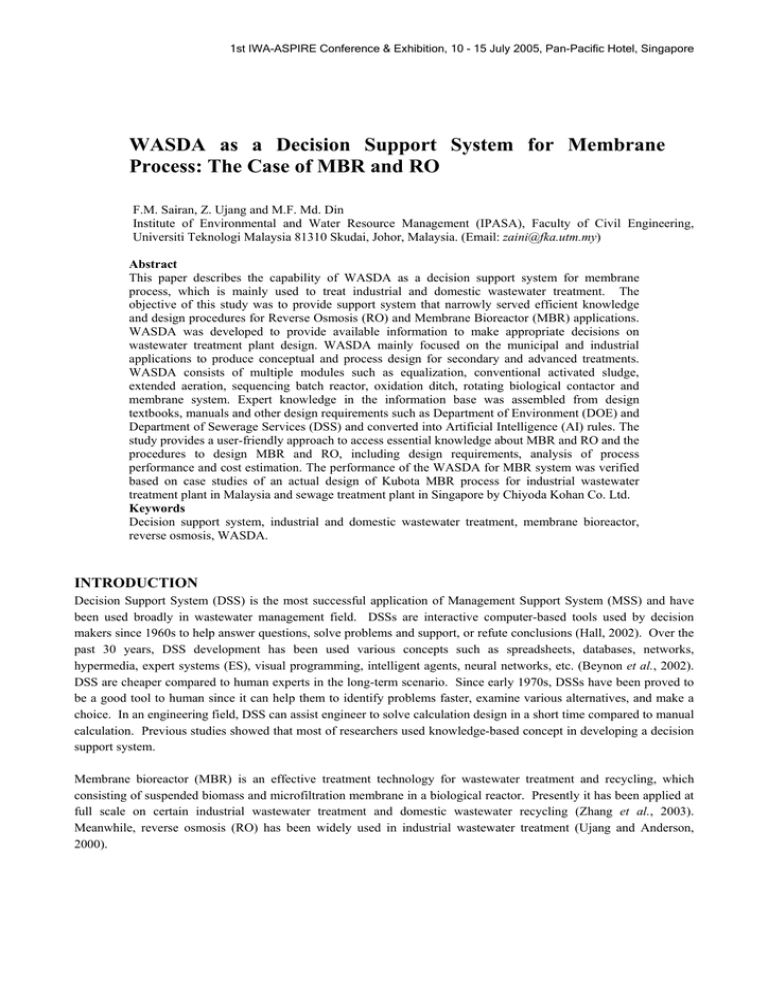
1st IWA-ASPIRE Conference & Exhibition, 10 - 15 July 2005, Pan-Pacific Hotel, Singapore WASDA as a Decision Support System for Membrane Process: The Case of MBR and RO F.M. Sairan, Z. Ujang and M.F. Md. Din Institute of Environmental and Water Resource Management (IPASA), Faculty of Civil Engineering, Universiti Teknologi Malaysia 81310 Skudai, Johor, Malaysia. (Email: zaini@fka.utm.my) Abstract This paper describes the capability of WASDA as a decision support system for membrane process, which is mainly used to treat industrial and domestic wastewater treatment. The objective of this study was to provide support system that narrowly served efficient knowledge and design procedures for Reverse Osmosis (RO) and Membrane Bioreactor (MBR) applications. WASDA was developed to provide available information to make appropriate decisions on wastewater treatment plant design. WASDA mainly focused on the municipal and industrial applications to produce conceptual and process design for secondary and advanced treatments. WASDA consists of multiple modules such as equalization, conventional activated sludge, extended aeration, sequencing batch reactor, oxidation ditch, rotating biological contactor and membrane system. Expert knowledge in the information base was assembled from design textbooks, manuals and other design requirements such as Department of Environment (DOE) and Department of Sewerage Services (DSS) and converted into Artificial Intelligence (AI) rules. The study provides a user-friendly approach to access essential knowledge about MBR and RO and the procedures to design MBR and RO, including design requirements, analysis of process performance and cost estimation. The performance of the WASDA for MBR system was verified based on case studies of an actual design of Kubota MBR process for industrial wastewater treatment plant in Malaysia and sewage treatment plant in Singapore by Chiyoda Kohan Co. Ltd. Keywords Decision support system, industrial and domestic wastewater treatment, membrane bioreactor, reverse osmosis, WASDA. INTRODUCTION Decision Support System (DSS) is the most successful application of Management Support System (MSS) and have been used broadly in wastewater management field. DSSs are interactive computer-based tools used by decision makers since 1960s to help answer questions, solve problems and support, or refute conclusions (Hall, 2002). Over the past 30 years, DSS development has been used various concepts such as spreadsheets, databases, networks, hypermedia, expert systems (ES), visual programming, intelligent agents, neural networks, etc. (Beynon et al., 2002). DSS are cheaper compared to human experts in the long-term scenario. Since early 1970s, DSSs have been proved to be a good tool to human since it can help them to identify problems faster, examine various alternatives, and make a choice. In an engineering field, DSS can assist engineer to solve calculation design in a short time compared to manual calculation. Previous studies showed that most of researchers used knowledge-based concept in developing a decision support system. Membrane bioreactor (MBR) is an effective treatment technology for wastewater treatment and recycling, which consisting of suspended biomass and microfiltration membrane in a biological reactor. Presently it has been applied at full scale on certain industrial wastewater treatment and domestic wastewater recycling (Zhang et al., 2003). Meanwhile, reverse osmosis (RO) has been widely used in industrial wastewater treatment (Ujang and Anderson, 2000). 1st IWA-ASPIRE Conference & Exhibition, 10 - 15 July 2005, Pan-Pacific Hotel, Singapore WASDA in perspective WASDA (Wastewater Treatment Plant Design Advisor) has been developed to be a decision support tool for design and process selection of wastewater treatment plant, in municipal and industrial sector. WASDA can support the production of conceptual and process design for primary, secondary and advanced treatments as proposed by best practices manuals or public authorities related to sewerage services or environmental control. The system includes design calculations, standard criteria, equipment selection, plans and specifications of various treatment units, which displayed as interactive graphic and user-friendly interfaces. MBR and RO modules are some of components provided in WASDA. The modules presented design calculation procedure and cost estimation based on theoretical consideration and standard criteria. METHODS System Plan To maximize the use of MBR and RO module in WASDA, the system were assured to be user-friendly and accessible. For this project, the user interface was significantly distress on its function. The programming tool used to design the system is Visual Basic 6.0 and integrated with Microsoft Access. The MBR and RO modules were divided into two main parts, which are (a) information section and (b) design calculation worksheet. The architecture of the MBR and RO modules, mostly on design calculation worksheet was modularly planned as shown in Figure 1. The input, processing and output steps were implemented on each worksheet. The different between calculation worksheet of WASDA and Excel is the hidden formula to avoid errorness if users key-in incorrect data. When user entered the WASDA Main Menu, he/she could select menu at the top of window to access design calculation screen. All data can be entered into boxes at input frame. Conceptual layout of the process for MBR treatment also displayed at the data input screen. Moreover, RO module can perform calculation on costing included capital and operating cost. System Analysis and Validation System prototype for RO and MBR are quickly developed and well demonstrated to users because input is used to refine the WASDA. The main advantage is that the WASDA can quickly provide to users, even though it may not be ready for institutional use. Feedback can be obtained and the system can be modified by moving to the next prototype. In fact, further analysis may need to be performed as well. A suitable verification and validation is then carried out. The WASDA at this stage is regularly being tested and validated by trial-and-error approach, which called ‘What-if” analysis. “What-if” analysis is structured as “What will happen to the solution if an input variable, an assumption, or a parameter value is changed”. For example, “What will happen to the volume of the aeration tank if the flowrate of the influent wastewater increases by 10 percent?” Furthermore, verification has been done by comparing manual calculations with calculation using the WASDA and also by existing calculation tool such as Excel. A few sets of data will be produced and the comparison will be made using a descriptive statistic analysis. Its performance was evaluated by performing a case study on the conceptual design for wastewater treatment plant in Malaysia. In the case of Membrane Bioreactor (MBR) System module, the test was based on Process Design of Kubota MBR Process for the project on Factory Industrial Waste Water Treatment. 1st IWA-ASPIRE Conference & Exhibition, 10 - 15 July 2005, Pan-Pacific Hotel, Singapore Data Input Data Processing Data Output Start Login Screen (Password required) Select Design Calculation Menu Design Calculation for Industrial Wastewater Treatment System Design Calculation for Municipal Wastewater Treatment System MBR* MBR* RO* Input Frame RO* Output Frame Input Frame Flowrate Design Parameter: BOD, TSS, TN, TP, O&G Ions & Salt Effective Membrane Area, Design Flux etc. Molecular Weight Design Requirement for Oxygen Absorption Efficiency Feed flow Design Requirement for Scouring Membrane Surface Design Requirement for Air Diffuser in Aeration Tank (Nitrification) Tank Dimension: - Membrane Tank - Aeration Tank - Balancing Tank Pipe Size: Pipe to Membrane Tank, Aeration Tank, Balancing Tank, and Permeate Pump Constant values Contaminant No. of Ions Temperature Membrane area - each element Rejection of Contaminants Feed concentration Coefficient of Water Permeation Operating Pressure RO* MBR* Safety Factor Output Frame Percent removal for BOD, TSS, TN, TP, O&G Pollutant loading Osmotic Pressure Membrane area required Number of membrane / unit, Design MLSS in Membrane tank, F/M Water Flux Oxygen Requirement for Respiration & Nitrification Permeate flow and concentration Membrane elements required Operating Costs Air flowrate - Aeration tank - Scouring membrane surface - Mixing of Balancing tank - Pipes Recovery rate Capacity of Equipments Costs Tank Volume Figure 1. Architecture of WASDA – MBR and RO modules (Design Calculation Worksheet) 1st IWA-ASPIRE Conference & Exhibition, 10 - 15 July 2005, Pan-Pacific Hotel, Singapore RESULTS AND DISCUSSION WASDA modules including RO and MBR were presented as user-friendly screens with selection menus and buttons. As shown in Figure 2, once all input data are entered, the user can click the “Calculate” button and automatically the result appeared in “Output Frame”. While, Figure 3 showed as a screen for cost estimation of RO treatment system. The “Design Flow” and “Conversion Unit” buttons were provided at the bottom of RO screen. This would allow user to access screen that can convert units for certain data such as feed flow, membrane area, plant capacity, production rate etc. The “Reset” button is used to rearrange the data to the standard setting when user wants to start a new calculation. Figure 2. Calculation Screen for RO Module: Ions & Salt Removal. Figure 3. Cost Estimation Screen for RO Module: Ions & Salt Removal. If user satisfied with the calculation, the results summary can be displayed as shown in Figure 4. The results can be printed out by clicking the provided button. Besides of Design Calculation screen, there were Information screens that provided the essentials knowledge of membrane treatment process and operations as shown in Figure 5. Figure 4. Result Summary Screen for RO Module: Ions & Salt Removal. Figure 5. Information Screen for RO module. Figure 6 and 7 showed input boxes for estimated values such as flowrate; design parameters (BOD, TSS, T-N, T-P and O&G); effective membrane area; design flux and design requirements for oxygen absorption efficiency, for scouring membrane surface and air diffuser in aeration tank. Furthermore, estimated values that should be added at Input Screen 1st IWA-ASPIRE Conference & Exhibition, 10 - 15 July 2005, Pan-Pacific Hotel, Singapore (as displayed in Figure 7) were consisted of Tank Dimension (membrane tank, aeration tank and balancing tank) and size of pipes to membrane tank, aeration tank, balancing tank and also permeate pump. The Output Screen was appeared when user clicked the “Calculate” button as shown in Figure 8 and 9. Based on these screens, the RO and MBR modules were not only allow users to find the best solution, but also enable the analysis of data when some input data was changed. These capabilities can also be used for minimization of capital and operating cost. Figure 6. Input Screen for MBR module – Part 1. Figure 7. Input Screen for MBR module – Part 2. Figure 8. Output Screen for MBR module – Part 1. Figure 9. Output Screen for MBR module – Part 2. CONCLUSION The visual-based of the system represents WASDA as a support tool for conceptual design of wastewater treatment plants. Design calculation for MBR and RO treatment were dependent on many variables. In that case, the creation of RO and MBR modules in WASDA system is useful to assist design engineers and consultant for making decision on plant, process performance and cost estimation (typically based on standard requirements). The widely use of the system whether at desktop or laptop computers give more advantages to user for making decision on wastewater treatment plant design in a minimal time. 1st IWA-ASPIRE Conference & Exhibition, 10 - 15 July 2005, Pan-Pacific Hotel, Singapore ACKNOWLEDGEMENTS The authors would like to acknowledge Universiti Teknologi Malaysia (UTM) for partly financing this study under Commercialization Fund (Vot 98255). NOMENCLATURE BOD Biochemical Oxygen Demand (mg/l) TSS Total Suspended Solids (mg/l) TN Total Nitrogen (mg/l) TP Total Phosphorus (mg/l) O&G Oil and Grease (mg/l) REFERENCES Ahmed, S.A, Tewfik, S.R., Ragheb S. and Talaat H.A. (2002). “Development and verification of a decision support system for the selection of optimum water reuse schemes.” Desalination. 152. 339-352. Beynon, M., Rasmequan, S. and Russ, S. (2002). “A New Paradigm for Computer-Based Decision Support” Decision Support Systems. 33. 127–142. Buehlmann, U., Ragsdale, C.T. and Gfeller B. (2000). “A Spreadsheet-Based Decision Support System for Wood Panel Manufacturing.” Decision Support System. 29. 207-227. Cortes, U., Sanchez-Marre, M., Ceccaroni, L., R-Roda, I. and Poch M. (2000). “Artificial Intelligence and Environmental Decision Support Systems.” Applied Intelligence 13. 77 – 91. Hall, M. (2002). “Decision-Support System” Computerworld (US). 2(11). Metcalf and Eddy (2003). “Wastewater Engineering Treatment and Reuse”. Fourth Edition, Mc Graw Hill, New York. Sairan F.M and Ujang Z. (2004) “Wastewater treatment plant design advisor using WASDA” Environmental Biotechnology, Water and Environmental Management Series, IWA Publishing, London. ISBN 1843395037. Ujang Z. and Anderson G.K. (2000). Effect of the operating parameters on the separation of metal chelates using low pressure reverse osmosis membrane. Wat. Sci.Tech., 41(10-11): 135-142. Zhang, S., R. van Houten, D. H. Eikelboom, H. Doddema, Z. Jiang, Y. Fan and J. Wang (2003). ‘Sewage Treatment by a Low Energy Membrane Bioreactor.’ Bioresource Technology. 90.(2): 185-192.
